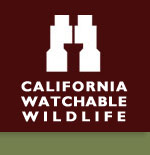

| Visitation: 1 million + | ||
| Area: 2,065 Acres | ||
| Lat: | ||
| Lon: | ||
| Nearby Services | ||
| Site Facilities | ||
| Join Our Mailing List |
|
For Email Marketing you can trust
|
Top Banner Photo Credits
Pam Starr
Alyn Robert Brereton
Julie MacKinnon
Linda Pittman
Parham Pourahmad
Larry Whiting
Randall Finley
Pam Starr
Alyn Robert Brereton
Julie MacKinnon
Linda Pittman
Parham Pourahmad
Larry Whiting
Randall Finley
© 2008-2024 California Watchable Wildlife and Blue Cat Studio, Inc.
| Mackerricher State Park - Site # 127 | |||
| Background: | Eight scenic miles of rocky coastline, beaches, and dunes combine with forests, seasonal streams, grasslands, and a lake to offer tremendous habitat diversity. Extensive barrier dunes support endangered plants and a rare dune beetle. Tidepools sparkle along the rocky shoreline near Laguna Point, where offshore rocks attract black oystercatchers and provide a rookery for harbor seals. Coastal waters include an underwater park. Inglenook Fen, an unusual wetland, supports salamanders, rare insects, and shorebirds. Waterfowl and wading birds frequent Lake Cleone and Mill Creek. Look for cedar waxwings and other songbirds in spring. During spring and fall migrations, large numbers of shorebirds can be observed on the sandy beaches. | ||
| Scheduled or guided activities, including hikes, Junior Ranger and campfire programs, are posted on bulletin boards throughout the park. During gray whale migration seasons, there are organized whale watches on Laguna Point. A mounted skeleton of a 30-foot gray whale is exhibited next to the visitor center at the park's entrance. Staffed by volunteers, the visitor center features interpretive displays and a gift shop with books and other printed matrial. | |||
| The Habitat: | (** I can't with any confidence hazard a guess as to the relative abundances, but here is a list of the habitats present:) Perennial grassland, coastal prairie, coastal scrub, coastal bluff, coastal terrace, valley foothill riparian, closed-cone pine-cypress, freshwater emergent wetland, coastal beach, coastal dune,lacustrine, marine, riverine, open redwood forest. | ||
| The Experience: | MacKerricher State Park and the Inglenook Fen/ Ten Mile Dune Preserve contain outstanding examples of several varied habitats. The State Park and Recreation Commission resolution which established the Preserve specifically distinguishes a variety of important elements: wetlands and riparian areas, a rare coastal dune ecosystem, the only remaining coastal fen in California, eight rare natural communities, and eight special plant species. The Sandhill Lake/Inglenook Fen/ Fen Creek Complex is the southernmost of a series of fens extending from Alaska south to this area, and is the only known remaining coastal Fen in California. In addition, MacKerricher State Park supports several species of rare, threatened and endangered species, including the Western Snowy Plover, Howell's spineflower, and Menzies's wallflower. | ||
| Wildlife and Where to Find It: | Car (especially at Lake Cleone), beach walk/hike, boardwalks and overlooks, non-motorized boats. Trails - range from easy to moderate; mostly flat. The main 'trail' through the park - and old logging road - is paved; some trails are dirt- or sand-surfaced. 'Off trail' viewing of wildlife is available within the Inglenook Fen/ Ten Mile Dune Preserve. (Except for the old logging road, there are few designated trails. Walking through the dunes, and on the beach, is permitted.) | ||
| Viewing Tips: | Over 100 bird species utilize the park's habitats. Many species of songbirds, shorebirds, waterfowl, wading birds, and raptors, as well as harbor seals and tidepool inhabitants, can be seen year-round. Brown pelicans, common murres, and ospreys can be seen spring through fall. Large flocks of migrating shorebirds are most common in spring and fall. Watch gray whales from December through March. Wildflowers bloom in spring and summer. TIDEPOOLS BEST AT LOW TIDE; DANGEROUS SURF. PLEASE DON'T DISTURB TIDEPOOLS OR SEAL ROOKERY. | ||
| Site Notes: | MacKerricher State Park's diversity, moderate climate and wild beauty make this special place on the Mendocino Coast a gem among California's state Parks. Watch harbor seals and migrating gray whales, stroll on secluded beaches, bicycle along an old logging road overlooking the sea, and experience the solitude of northern California's most pristine stretch of sand dunes. (*from brochure*) | ||
| Visitor Information: | Fort Bragg/Mendocino Chamber of Commerce - (707) 961-6300 - http://www.mendocinocoast.com/ | ||
| Viewing Site Hours of Operation are: | |||
| Staff On-site: | Yes | ||
| Open: | Everday | ||
| Hours: | 6 am to sunset | ||
| Year Round: | Yes | ||
| Road Information: | |||
| Road Hazards: Not usually (sometimes seasonally, during severe storms or heavy rain). | |||
| Parking Fee: No | |||
| Proximity to viewing area:varies by site from a few steps, to long hikes. | |||
| Parking Notes: MacKerricher State Park is large. In general, it is not necessary to pull off at the shoulder of the road. In many areas, official or unofficial parking lots afford access. Free Day Use within the Park makes it unnecessary to stop one's vehicle outside, as opposed to parking within it. One potential hazard of not parking in designated areas is that Highway One borders the park to the east; crossing the Highway can be hazardous without proper precautions. | |||
| How to Get There: | From Fort Bragg, travel north on Highway 101 for 3 miles to park entrance, on the west side of the highway. | ||
| Contact Information | |||
| Managing Agency: | California State Parks | ||
| Agency Site URL: | http://www.parks.ca.gov/default.asp?page_id=436 | ||
| Physical Address: | , CA |
Agency 2: | PO Box 440 Mendocino, CA 95460 |
| Manager Phone: | (707) 964-9112 or (707) 937-5804 | ||
| Site Phone: | (707) 964-9112 or (707) 937-5804 | ||
| County: | Mendocino | ||
| Addition Website: | |||
